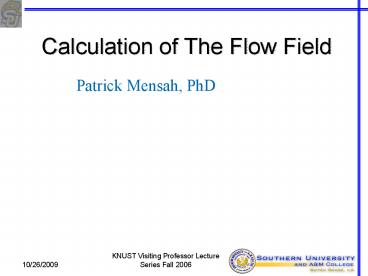Calculation of The Flow Field - PowerPoint PPT Presentation
1 / 25
Title:
Calculation of The Flow Field
Description:
Use of Vorticity-Based Methods: This approach eliminates the pressure from the ... two equation for the stream function and the vorticity. Disadvantage is that ... – PowerPoint PPT presentation
Number of Views:57
Avg rating:3.0/5.0
Title: Calculation of The Flow Field
1
Calculation of The Flow Field
- Patrick Mensah, PhD
2
Introduction
- Introduction of need in calculating flow field
variable u, v, w, P - Difficulties in calculating flow field variable
u, v, w, P - Representation of the Pressure Gradient Term
- Representation of the Continuity Equation
- Recommended Remedy Staggered Grid Approach
3
Introduction
- The Momentum Equations
- The Pressure and Velocity Corrections
- The Pressure-Corrections Equation
- The SIMPLE Algorithm
- A Revised Algorithm SIMPLER
- Summary
4
Introduction of need in calculating flow field
variables
- Low field variable are usually unknown
- Local flow field velocity components are usually
calculated from governing equations - Even though flow field velocities can be obtained
from the momentum equation, the difficulty is
that the pressure gradient term is unknown
5
Introduction of need in calculating flow field
variables
- Some approaches to resolving unknown pressure
gradient issue - Use of Vorticity-Based Methods This approach
eliminates the pressure from the governing
equations- do problem 6.1 - Results in the solution of two equation for the
stream function and the vorticity - Disadvantage is that
- it is not applicable in 3-D flows since stream
functions do not exist, - pressure may be needed in calculating flow
properties such as density
6
Difficulties in calculating flow field variable
u, v, w, P
- Representation of the Pressure Gradient Term
- Integrating over the control volume results in
Pw-Pe contribution to the discretization equation
7
Difficulties in calculating flow field variable
u, v, w, P
- This gives us the net pressure force exerted on
the control volume - In order to represent the net pressure in term s
of grid point values a piecewise linear profile
is assume giving - The result is that the momentum equation will
contain pressure difference between two alternate
grid points and not adjacent ones
8
Difficulties in calculating flow field variable
u, v, w, P
- Gives unrealistic pressure field
9
Difficulties in calculating flow field variable
u, v, w, P
- Representation of the Continuity Equation
- Again results in unrealistic velocity field which
demands equality of velocities at alternate grid
points
10
Recommended Remedy Staggered Grid Approach
- Recognizing that calculation of all variables
does not have to be at the same grid point hence
location of u velocities
11
Recommended Remedy Staggered Grid Approach
- location of u and v velocities
12
Recommended Remedy Staggered Grid Approach
- Advantages
- Discretized continuity equation would contain
differences of adjacent velocity components - The staggered grid results in a pressure
difference between adjacent points that becomes
the driving force for the velocity components
located between the grid points
13
The Momentum Equations
- Control volume for u
14
The Momentum Equations
- Control volume for v
15
The Momentum Equations
- When the pressure field is given or estimated the
velocity field can be obtained from the following
discretized equations momentum equations - Where , u, v and w denotes a starred or
estimated velocity field from P
16
The Pressure and Velocity Corrections
17
The Pressure Correction Equation
- Continuity Equation
18
The Pressure Correction Equation
19
The Pressure Correction Equation
20
SemiImplicit Method for Pressure-Linked
Equations (SIMPLE ALGORITHM)
- Guess the pressure field P.
- Solve the momentum equations, such as Eqs.
(6.8)-(6.10), to obtain u, v w - Solve the p' equation.
- Calculate p from Eq. (6.11) by adding P' to P.
- Calculate u, v, w from their starred values using
the velocity-correction formulas (6.17)-(6.19).
21
SIMPLE ALGORITHM
- 6. Solve the discretization equation for other ?
(such as temperature, concentration, and
turbulence quantities) if they influence the flow
field through fluid properties, source terms,
etc. (If a particular ? does not influence the
flow field, it is better to calculate it after a
converged solution for the flow field has been
obtained.) - 7. Treat the corrected pressure p as a new
guessed pressure p, return to step 2, and repeat
the whole procedure until a converged solution is
obtained.
22
Things to note about the pressure correction
equation
23
A Revised Algorithm SIMPLER
- Improves on the convergence of SIMPLE
- Improves obtaining corrected pressure field
- Faster convergence for 1-D problems
- No guess pressure required but extracts pressure
from a given velocity field - No need for further iterations when given
velocities happen to be the correct velocity
field - However, more computational effort is required
with SIMPLER than SIMPLE even though fewer
iterations for convergence
24
A Revised Algorithm SIMPLER
- Guess the velocity field v.
- Calculate the coefficients for the momentum
equations and hence calculate from
equations such as Eq. 6.26 by substituting the
values of the neighbor velocities unb - Calculate the coefficients for the pressure
equation 6.30, and solve it to obtain the
pressure field - Treating the pressure field as P, solve the
momentum equations, such as Eqs. (6.8)-(6.10), to
obtain u, v w
25
A Revised Algorithm SIMPLER
- 5. Calculate the mass source b eq. 6.23h and
hence solve the p' equation. - 6. Correct the velocity field u, v, w from their
starred values using the velocity-correction
formulas (6.17)-(6.19). Do not correct the
pressure - 7. Solve the discretization equation for other ?
if necessary - 8. Return to step 2, and repeat the whole
procedure until a converged solution is obtained.































